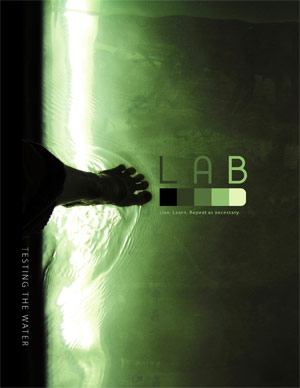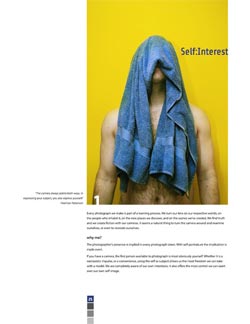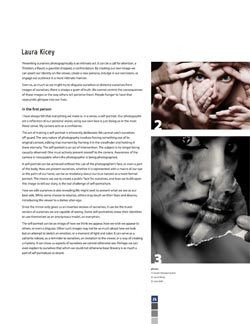Every photograph we make is part of a learning process. We turn our lens on our respective worlds, on the people who inhabit it, on the new places we discover, and on the scenes we’ve created. We find truth and we create fiction with our cameras. It seems a natural thing to turn the camera around and examine ourselves, or even to recreate ourselves.
why me?
The photographer’s presence is implied in every photograph taken. With self-portraiture the implication is made overt.
If you have a camera, the first person available to photograph is most obviously yourself. Whether it is a narcissistic impulse, or a convenience, using the self as subject allows us the most freedom we can take with a model. We are completely aware of our own intentions. It also offers the most control we can exert over our own self-image.
Presenting ourselves photographically is an intimate act. It can be a call for attention, a flirtation, a flaunt, a gauntlet dropped, a confrontation. By creating our own image we can assert our identity on the viewer, create a new persona, indulge in our narcissism, or engage our audience in a more intimate manner.
Even so, as much as we might try to disguise ourselves or distance ourselves from images of ourselves, there is always a grain of truth. We cannot control the consequences of those images or the way others will perceive them. People hunger to have that voyeuristic glimpse into our lives.
in the first person
I have always felt that everything we make is, in a sense, a self-portrait. Our photographs are a reflection of our personal vision; using our own face is just doing so in the most literal sense. My camera acts as a confidante.
The act of making a self-portrait is inherently deliberate. We cannot catch ourselves off-guard. The very nature of photography involves forcing something out of its original context, editing that moment by framing it in the viewfinder and holding it there eternally. The self-portrait is an act of intervention. The subject is no longer being casually observed. One must actively present oneself to the camera. Awareness of the camera is inescapable when the photographer is being photographed.
A self-portrait can be achieved without the use of the photographer’s face, or even a part of the body. How we present ourselves, whether it is represented with a macro of our eye or the palm of our hand, can be as revelatory about our true natures as a more formal portrait. The means we use to create a public ‘face’ for ourselves, and how we build upon this image to tell our story, is the real challenge of self-portraiture.
How we edit ourselves is also revealing.We might seek to present what we see as our best side. While some choose to idealize, others may touch on their fears and dreams, introducing the viewer to a darker alter-ego.
Since the mirror only gives us an inverted version of ourselves, it can be the truest version of ourselves we are capable of seeing. Some self-portraitists erase their identities to use themselves as an anonymous model, an everyman.
The self-portrait can be an image of how we think we appear, how we wish we appear to others, or even a disguise. Other such images may not be so much about how we look but an attempt to sketch an emotion, or a moment of light and color. It can serve as a cathartic release, as a reminder to ourselves, an invitation to the viewer, or a way of creating a mystery. It can show us aspects of ourselves we cannot otherwise see. Perhaps we can even explain to ourselves that which we could not otherwise bear. Bravery is as much a part of self portraiture as deceit.
As a photographer who makes self-portraits and posts them on the internet, I have gained an awareness of the dynamic between being a viewer and being the viewed. I often use self-portraits as emotional markers in time, so my self-explorations become both internal and external. After experiencing something intense, I want to create something as both a reaction and a reminder. It helps me process it, honor the memory, and move on.
The choices we make in creating our own images are as complex as we are as a person. What the viewer makes of it is another part of the equation in this silent social interaction.
through other’s eyes
In an age when more and more our initial ‘meetings’ with people are less frequently face-to-face, self-portraiture often replaces a handshake and a smile . It is a very human response to want to put a face to the work, the words.
Looking at self-portraits of other photographers can give us a rich sense of character; the creative manner in which they use themselves to tell stories, create abstractions, or pin down an emotional state is very telling. I also want to see if their vision of themselves matches the rest of what they make. It’s fascinating to watch someone new to self-portraiture unfold and develop, to observe things begin to form parallels and overlap.
I also find looking at self portraits helps me develop a sense of how to shoot portraits of other people. I gain a new understanding of what angles emphasize different aspects of the face, how the face wears an expression. The more clearly I can see myself, the more clearly I can see everything around me. On a more empathetic level, I learn what is comfortable to do in front of the camera.
questioning the self
When are we most whole and true before the camera? At our worst? Our best? When we wake, while we sleep? While not observed? Behind our everyday mask or when we take it off? In a sense, a self-portrait is the ultimate dramatization.
It’s important to remember that we are not frozen in time in that frame of 1/100th of a second. Do we ever paint a complete picture? Since we are always changing, perhaps when we pose the question to ourselves with the camera, the answer is always different. And it is never the wrong answer. ¤



